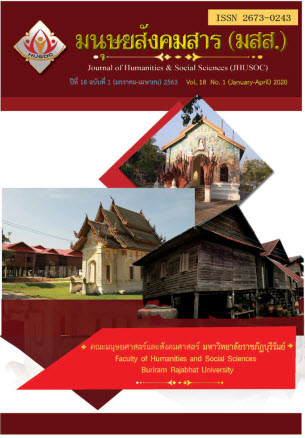Semantic Change of the Word /khraj2/ ‘to love, to like’ in Thai
Main Article Content
บทคัดย่อ
The purpose of this study was to study the semantic change of the word /khraj2/ from Sukhothai to 2018 A.D. The Collected data were divided into 6 periods namely; 1) Sukhothai 2) Ayutthaya 3) the reign of King Rama I – III 4) the reign of King Rama IV - V 5) the reign of King Rama VI - VIII and 6) the reign of King Rama IX - 2018 A.D. The data were based on published documents from 1283 to 2018 A.D. The study revealed that /khraj2/ is defined into 4 meaning: 1) ‘to love, to like’ 2) ‘to want, to desire’ 3) ‘to think, to cogitate, to examine’ and 4) ‘not, not all’. Other major 3 meanings at first were found since Sukhothai period. Meaning ‘to love, to like’ gradually changed to a negative sexual semantic feature. Meaning ‘to want, to desire’ could be used for polite requests and official documents at the reign of King Rama IX period. However, meaning ‘to think, to cogitate, to examine’ had the least semantic change. Meaning ‘not, not all’ appeared in / maj2khraj2/ since the reign of King Rama I period and it had functioned similarly to negative marker.
Article Details
เนื้อหาและข้อมูลในบทความที่ลงตีพิมพ์ในวารสารทดสอบระบบ ThaiJo2 ถือเป็นข้อคิดเห็นและความรับผิดชอบของผู้เขียนบทความโดยตรงซึ่งกองบรรณาธิการวารสาร ไม่จำเป็นต้องเห็นด้วย หรือร่วมรับผิดชอบใดๆ
บทความ ข้อมูล เนื้อหา รูปภาพ ฯลฯ ที่ได้รับการตีพิมพ์ในวารสารทดสอบระบบ ThaiJo2 ถือเป็นลิขสิทธิ์ของวารสารทดสอบระบบ ThaiJo2 หากบุคคลหรือหน่วยงานใดต้องการนำทั้งหมดหรือส่วนหนึ่งส่วนใดไปเผยแพร่ต่อหรือเพื่อกระทำการใดๆ จะต้องได้รับอนุญาตเป็นลายลักอักษรจากวารสารทดสอบระบบ ThaiJo2 ก่อนเท่านั้น
เอกสารอ้างอิง
Anuphaptriphop, Phraya. (1934). Sociability: the Westerner’s Tradition and Customs. Phranakhorn:
Krungthepbannakhan. [in Thai]
Bhanubhan wongworadeja, His Royal Highness Prince Krom Phraya. (1968). Chiwiwat Thiaothitangtang Episode
(4th ed.). Phranakhon: Fine Arts Department. [in Thai]
Bybee, J., Perkins, R., and Pagliuca, W. (1994). The Evolution of grammar: Tense, aspect and modality in the
languages of the world. Chicago: Chicago University press.
Chulalongkorn, King. (1907). Klai-Ban. Retrieved from https://vajirayana.org/. [in Thai]
Chuwicha, Y. (1993). Clausehood in serial verb constructions in Thai (Master’s thesis). Retrieved from
Chulalongkorn University Intellectual Repository. [in Thai]
Damrong Rajanubhab, His Royal Highness Prince Krom Phraya. (1946). Traveling to Myanmar. Retrieved from
https://vajirayana.org/. [in Thai]
Fine Arts Department. (1978). The Three Seals Law. Bangkok: Fine Arts Department. [in Thai]
__________. (1987). Luang Udom Sombat's Epistle. Retrieved from https://vajirayana.org/. [in Thai]
__________. (2008). Traiphumphraruang. Retrieved from https://vajirayana.org/. [in Thai]
Jaratjarungkiat, S. (2008). /jaŋ/: A diachronic study (Master’s thesis). Retrieved from Chulalongkorn University
Intellectual Repository. [in Thai]
Leech, G. (1983). Principles of Pragmatics. London: Longman. Linguistics Department Faculty of Arts
Chulalongkorn University. (2007). Thai
National Corpus. Retrieved from https://www.arts.chula.ac.th/ling/tnc/. [in Thai]
Mahaammatthipbodi, Phraya. (1928). The Rivers in Siamese. (2nd ed.). Phranakhon: Sophonphiphatthanakon. [in
Thai]
Matichon Press. (2004). Matichon dictionary of the Thai language. Bangkok: Matichon Press. [in Thai]
Muangkaew, N. (2013). Requestive markers in Thai: a grammaticalization approach (Master’s thesis) Retrieved
from Chulalongkorn University Intellectual Repository. [in Thai]
Munlee, L. and Srithep, U. (Eds.). (2010). Ayutthaya Testimonies. Bangkok: Saengdao. [in Thai]
Na nakorn, P. (1991). Thai-Assamese Dictionary. Bangkok: Fine Arts Department. [in Thai]
Nangklao, King. (1922). King Nangklao’s the royal questions. Phranakhon: Krungthepbannakhan. [in Thai]
Office of the Council of State. (1996). The Prostitution Prevention and Suppression Act 2539 B.E. Retrieved from
https://web.krisdika.go.th. [in Thai]
Official of the Royal Institute. (1988). Royal Institute Dictionary 2525 B.E.Bangkok: Aksorncharoentat. [in Thai]
__________. (2013). Royal Institute Dictionary 2554 B.E. Retrieved from https://www.royin.go.th/dictionary. [in Thai]
Phanthumetha, N. (2015). Thai Grammar. (7th ed.). Bangkok: Chulalongkorn University. [in Thai]
Princess Maha Chakri Sirindhorn Anthropology Centre. (2007). King
Ramkhamhaeng inscription. Retrieved from https://db.sac.or.th/inscriptions. [in Thai]
__________. (2016). Panangkhamyia inscription. Retrieved from https://db.sac.or.th/inscriptions. [in Thai]
Saipanyarangsit School. (2018). Saipanyarangsit School official documents. Unpublished manuscript. [in Thai]
Sawasdee, Bh. (2018). Tai Khao in Vietnam: The Correlation of Tai Identity. Dhammathas Academic Journal, 18(1),
-235. [in Thai]
Soithurm, A. (2010). The polyfunctionality of ca? in Thai (Master’s thesis) Retrieved from Chulalongkorn
University Intellectual Repository. [in Thai]
SommotAmarabhan, His Royal Highness Prince Krom Phra. (1929). His Royal Highness Prince Krom Phra
SommotAmarabhan’s Diaries. Phranakhorn: Yimsri Printing. [in Thai]
The Prime Minister's Office. (1978). Inscriptions annals episode 1 Sukhothai inscriptions before 2467 B.E.
Bangkok: The Prime Minister's Office. [in Thai]
Thiphakonrawongmahakosathipbodi, Chao Phya. (1970). Kitchanukit. Phranakhorn: Kurusapa Printing. [in Thai]
Vibhavadi rangsit, Her Royal Highness Princess. (2012). Nick and Pim. (7th ed.). Bangkok: Ton-or Grammy. [in
Thai]
Wate. (1924, May 3). Opinion of Mr. Thin. Dusit Samit. Retrieved from
https://www.car.chula.ac.th/rarebook/book2/Clra54_0234/mobile/index. html. [in Thai]
Yuttapongtada, M. (2012). Function and Semantic Extension of the Word /tua/ from the Sukhothai Period to B.E.
(Master’s thesis) Retrieved from Thai National Research Repository. [in Thai]
__________. (2012). an Assumption on Words [tua] and [ton]. Damrong journal, 17(2), 238-256. [in Thai]


